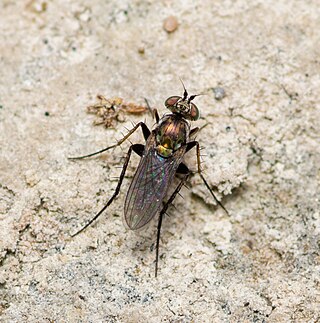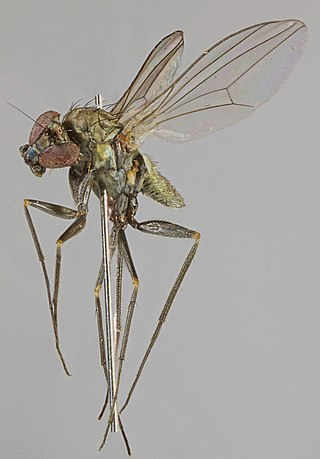
Dolichopodidae, the long-legged flies, are a large, cosmopolitan family of true flies with more than 7,000 described species in about 230 genera. The genus Dolichopus is the most speciose, with some 600 species.
Dolichophorus is a genus of flies in the family Dolichopodidae. It includes eight species distributed in the Palaearctic and Afrotropical realms. The adults have a metallic green, green-black or blue-black body coloring, with some pruinescence.

Medetera is a large genus of flies in the family Dolichopodidae. It includes about 350 species worldwide. The adults are commonly found resting on vertical surfaces such as tree trunks, on which they have a characteristic vertical upright stance. Because of this stance, they are sometimes known as "woodpecker flies". Medetera adults are predators of soft-bodied arthropods, while the larvae are predators of bark beetle larvae.
Mesorhaga is a genus of flies in the family Dolichopodidae.

Paraclius is a genus of flies in the family Dolichopodidae. It is currently considered a polyphyletic assemblage of species.
Saccopheronta is a genus of flies in the family Dolichopodidae. It is considered a synonym of Medetera by some authors, and a valid genus by others.

Sciapus is a genus of long-legged flies in the family Dolichopodidae. There are about 82 described species in Sciapus.

Thinophilus is a genus of flies in the family Dolichopodidae. It includes about 146 described species distributed worldwide. Most species of the genus are found in coastal habitats, while a few species are found in freshwater habitats.

Sciapodinae is a subfamily of flies in the family Dolichopodidae.

Medeterinae is a subfamily of flies in the family Dolichopodidae.

Mexican amber, also known as Chiapas Amber is amber found in Mexico, created during the Early Miocene and middle Miocene epochs of the Cenozoic Era in southwestern North America. As with other ambers, a wide variety of taxa have been found as inclusions including insects and other arthropods, as well as plant fragments and epiphyllous fungi.

Peloropeodinae is a subfamily of flies in the family Dolichopodidae. In some classifications, the genera of the subfamily are included in Sympycninae. According to a molecular phylogenetic analysis of the family Dolichopodidae by Germann et al. (2011), the subfamily is polyphyletic.

Medetera truncorum is a species of fly in the family Dolichopodidae. It is widely distributed in the Western Palaearctic. It also occurs in the Pacific Northwest in North America, where it may be an introduced species.

Dendroctonus terebrans, the black turpentine beetle, is a species of bark beetle native to the eastern United States. Its larvae tunnel under the bark of pine trees, weakening and sometimes killing the trees.
Demetera is a genus of flies in the family Dolichopodidae. It contains eight species formerly included in Medetera in the M. melanesiana species group. The species are found in the Afrotropical, Oriental and Australasian regions. According to Naglis and Bickel (2012), it was unwarranted to establish a separate genus for this group of species.
Medetera arnaudi is a species of long-legged fly in the family Dolichopodidae. It is known from the Central Valley and Coast Ranges of California. It is named after the entomologist Paul H. Arnaud, Jr., who collected the type specimens.
Medetera aberrans is a species of long-legged fly in the family Dolichopodidae. It is distributed in Eastern North America. Adults of the species are generally colored a metallic green, with yellow legs. Not much is known about the biology of the species, but adults have frequently been collected from wet grasslands or marshes.
Medetera apicalis is a species of long-legged fly in the family Dolichopodidae. It is found in Europe and North America. This species is more common in old-growth forest habitats, where it can be found beneath bark or on the fruiting bodies of wood-decaying fungi such as Fomitopsis pinicola.
Asioligochaetus is a disputed genus of flies in the family Dolichopodidae. It contains only one species, Asioligochaetus vlasovi, which is distributed in Central Asia. Asioligochaetus was originally proposed as a subgenus of Medetera by Oleg Negrobov in 1966. In Bickel (1985)'s revision of the Nearctic Medetera species, Asioligochaetus was treated as a synonym of Medetera, with the only species included as a member of the petulca species group. Alternatively, because of its peculiar combination of characters, Asioligochaetus was raised to genus rank by Igor Grichanov in 2009.









